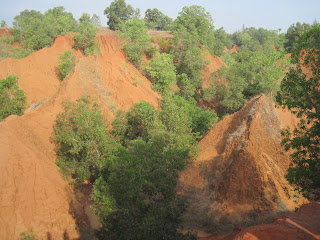My flight from Hong Kong arrived in Chennai at 2:00 am on Saturday November 26. I had a lengthy wait until my flight to Visakhapatnam left at 9:30. Curiously that 1 hour 50 minute flight arrived half an hour early, so I had to wait around for the driver to come to take me to the house of my friend and colleague Rani Sarma.
I came to Visakhapatnam to make arrangements for my two-week archaeology survey project to investigate some early Buddhist sites in the district and some Dutch and British colonial buildings in the town of Bhimunipatnam to the north of Visakhapatnam.
That day, I spoke with Rani at length about the project, and a nephew helped me with such tasks as getting an Indian SIM card for my cell phone, something that within the last two years has become a hassle for foreigners to get.
The next day, Sunday November 27, I joined a nature walk in the morning organized by INTACH (Indian National Trust for Art and Cultural Heritage) – Rani is the head of the Visakhapatnam chapter – at some scenic sand dunes north of the city that are threatened with destruction for a housing colony. A local geologist spoke about the dunes to the group.
A recently installed property line marker for the housing colony
The breakfast buffet at the local Presidential School
T hen Rani and I picked up Venkatesh Rao, a local amateur archaeologist, back in Visakhapatnam, and we proceeded south of the city to Peda Uppalam, a small village where the principal Buddhist site that we want to investigate is located. After walking around the site for a few hours we returned to Visakhapatnam.
The site of Peda Uppalam is located in the middle of recently flattened agricultural fields, so there is little beyond scattered sherds and brick fragments on the surface to point to any archaeological site. But along with a few boulders with cut markings, one major indication that there was once an early Buddhist site here is a statue of the Buddha that a local farmer found some decades ago. He built a small structure for the stature as a modern shrine.
Venkatesh Rao had visited the site over the years, but there has not yet been any formal description of the site or publication of the Buddha statue.
I came to Visakhapatnam to make arrangements for my two-week archaeology survey project to investigate some early Buddhist sites in the district and some Dutch and British colonial buildings in the town of Bhimunipatnam to the north of Visakhapatnam.
That day, I spoke with Rani at length about the project, and a nephew helped me with such tasks as getting an Indian SIM card for my cell phone, something that within the last two years has become a hassle for foreigners to get.
The next day, Sunday November 27, I joined a nature walk in the morning organized by INTACH (Indian National Trust for Art and Cultural Heritage) – Rani is the head of the Visakhapatnam chapter – at some scenic sand dunes north of the city that are threatened with destruction for a housing colony. A local geologist spoke about the dunes to the group.
The dunes
The group walking among the dunes
Rani and the geologist
After the walk, a nearby school hosted the group for breakfast. Curiously, the school uses a Canadian curriculum.
The breakfast buffet at the local Presidential School
The site of Peda Uppalam is located in the middle of recently flattened agricultural fields, so there is little beyond scattered sherds and brick fragments on the surface to point to any archaeological site. But along with a few boulders with cut markings, one major indication that there was once an early Buddhist site here is a statue of the Buddha that a local farmer found some decades ago. He built a small structure for the stature as a modern shrine.
Venkatesh Rao had visited the site over the years, but there has not yet been any formal description of the site or publication of the Buddha statue.
Venkatesh Rao and Rani at a boulder with some cut marks
The modern shrine for the Buddha statue
The next day, Monday November 28, Rani introduced me to various INTACH people, and we went to visit L. Suryanaranya, a professor at Andhra University who is interested in the early Buddhist presence. That night I took an overnight train to Hyderabad.







No comments:
Post a Comment